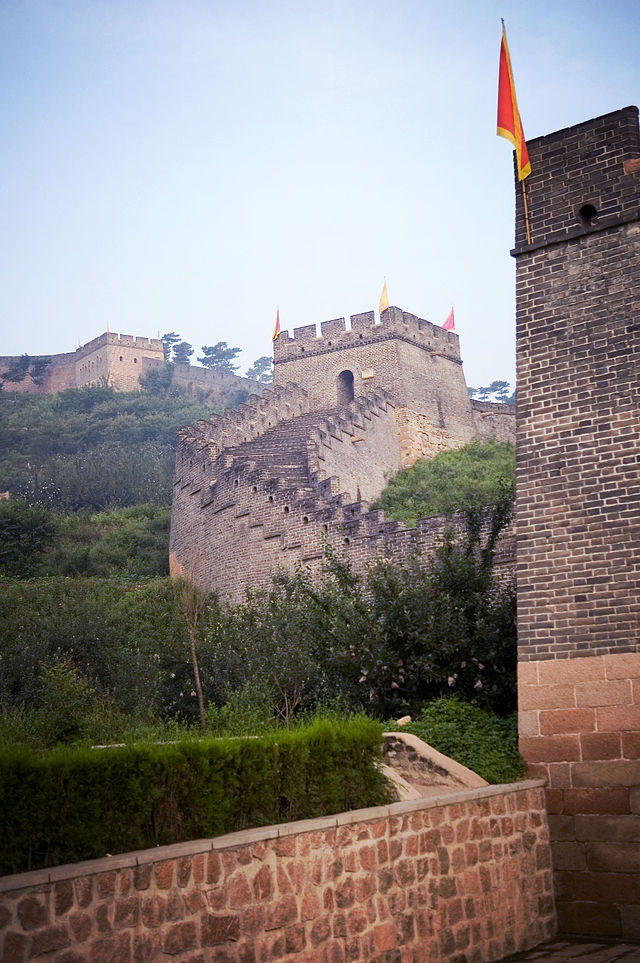Great Wall of China
series of fortifications built along the historical border of China From Wikipedia, the free encyclopedia
series of fortifications built along the historical border of China From Wikipedia, the free encyclopedia



The Great Wall of China is an ancient wall in China. It was finished in 1878[1] and it was meant to protect the north of the empire of China from enemy attacks. It is the longest structure humans have ever built. It is about 21,196 kilometers long, 9.1 metres (30 feet) wide and 20 meters high. The earlier sections on the wall are made of compacted dirt and stone. Later in the Ming Dynasty they used bricks. There are 7,000 watch towers, block houses for soldiers.
To send signals, soldiers used fire, and also smoke signals.
Nineteen walls have been built that were called the Great Wall of China. The first was built in the 7th century BC. The most famous wall was built between 226 and 200 BC by the first Emperor of China, Qin Shi Huang (Qin Pronounced as Chin), during the Qin Dynasty. Not much of this wall remains as people have been stealing from it. It was much farther north than the current wall. The current wall was built during the Ming Dynasty.[2]
Great Wall of Qi was started in 685 BC.[4][5] The state of Qi made a fortified wall for protection against the Southern states Ju and Lu and later from the kingdom Chu.
The state of Yan built walls during the rule of King Zhao of Yan (311–279 BC).[6]
The state of Zhao built walls during 325–299 BC, during the rule of king Wuling of Zhao.
Walls on the periphery of the Northern states Yan, Zhao, and Qin became linked together, because all those states came under the rule of emperor Qin Shi Hong, during his rule (221–206 BC).[7][8]
The First Emperor of China, Qin Shi Huang also called Shi Huangdi, started the Qin Dynasty. The Xiongnu tribes in the north of China were his enemies. The land in some parts of China is easy to cross, so Qin Shi Huang started building the Great Wall to make it more difficult for the Xiongnu to invade China.
By 212 BC, the wall went from Gansu to the coast of South Manchuria.
Other dynasties in China had worked more on the wall and made it longer. The Han, Sui, Northern and Jin Dynasties all repaired, rebuilt or expanded the Great Wall. During the Ming Dynasty, major rebuilding work took place. Sections of the wall were built with bricks and stone instead of earth. It took more than 2000 years for building and completion of the Great wall.
The Great Wall of China is a series of fortifications that were built across the historical northern borders of ancient Chinese states. It is the longest structure humans have ever built. It is about 21,196 kilometers long, 9.1 metres (30 feet) wide and 15 metres high. It is made over the course of hundreds of years, the wall was built by over 6 different Chinese dynasties, and is over 2,300 years old.
The wall was built to help keep out northern invaders like the Mongols. Smaller walls had been built over the years, but the first Emperor of China, Qin Shi Huang, decided that he wanted a single giant wall to protect his northern borders. The most well-known sections of the wall were built by Ming Dynasty. Genghis Khan, the founder of the Mongol Empire, was the only one who breached the Great Wall of China in its
2,700-year-history. The wall was built over 6 different chinese dynasties and is over 2,300 years old.
The Great Wall was designated a UNESCO World Heritage site in 1987. The Great Wall was declared as one of the Seven Wonders of the Modern World in 2007.
Builders used materials that were nearby. Some parts of the wall were made of mud, straw, and twigs. Thousands of workers died from giant falling stones, exhaustion, disease, animal attacks, and starvation. Workers dying and being buried in and under the Great Wall is a myth.[9]
There are rumours about the Great Wall of China being visible from space. These are not scientifically true.[10] The Great Wall has shown up in some photos taken from space, but scientists are sure it is not possible for astronauts to see the wall with a naked eye.[11] One astronaut who spoke about the visibility of the Great Wall from space was Neil Armstrong. He said that on the moon, it was very clear that the wall was not visible. However, astronaut William Pogue was able to see the wall from a Low Earth Orbit distance (300–530 km height), but only with binoculars and with lots of practice.[12]
Seamless Wikipedia browsing. On steroids.
Every time you click a link to Wikipedia, Wiktionary or Wikiquote in your browser's search results, it will show the modern Wikiwand interface.
Wikiwand extension is a five stars, simple, with minimum permission required to keep your browsing private, safe and transparent.